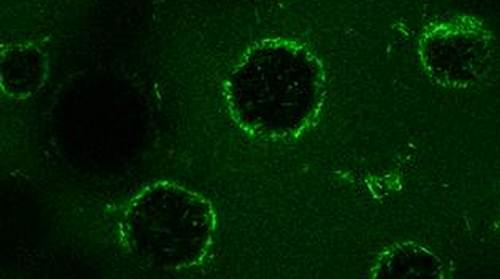Imagine a chocolate bar that is low in fat yet tastes just as luxurious as its full-fat counterpart. Thanks to world-leading research by our chemical engineers, you may not have to imagine for much longer.
 Image: an emulsion like that you would find in margarine; the glowing spots are particles that are stabilising the emulsion.
Image: an emulsion like that you would find in margarine; the glowing spots are particles that are stabilising the emulsion.
Scientists at the Centre for Formulation Engineering – part of the School of Chemical Engineering – have found the solution to making foods healthier but without compromising their taste and texture.
Working closely with the food industry, the aim is to help reduce food-related diseases like obesity and hypertension by encouraging the population to cut down on sugar, fat and salt.
Until now, the big problem has been that low-fat and low-sugar varieties of convenience foods simply aren’t as flavoursome and therefore not as appealing. What’s more, many such products replace natural ingredients such as fat and salt with artificial alternatives, thus compromising their ‘healthiness’.
What we do is to use process science to understand and manipulate food on the microscale to engineer products that deliver consumer expectation but with controlled energy and salt delivery so as to give a dramatic reduction in the amounts of fat, sugar and salt consumed in the diet.
For example, we have found a way to substitute some or most of the fat globules in foodstuffs such as chocolate, mayonnaise and margarine with alternative, natural materials such as water.
So successful is our research that the food industry may be only two years away from bringing to market products that are as healthy as they are indulgent.
Our research is not just geared towards food: we are also using formulation engineering in a variety of fields – all end user-driven – including pharmacy, medicine and catalysis and chemical reaction engineering.
Tissue engineering
We are working with Birmingham Medical School to develop cell therapy treatments for regenerating diseased or damaged bones, cartilage, ligaments, skin and even eyes, and to improve the body’s ability to heal.‘
This might seem a million miles away from chocolate, but the principles are the same,’ says Professor Liam Grover, whose expertise is in tissue regeneration.
Professor Grover is part of a team that is designing a material that is structured in a way that encapsulates cells and locates them in a position where they have a therapeutic effect.
The release of the restructured cells is done in a controlled way so as to enhance their therapeutic effect.
Professor Grover’s current research focuses on taking a population of cells from a person’s own tissues, encapsulating them into a gel – which acts as a filler – and injecting it into that person’s body. ‘From there, the cells will excrete growth factors, which will encourage healing,’ he explains.
As our knowledge of biological systems improves, we are moving from the use of materials as crude compositional mimics to designing ones that can interact with specific biological processes to enhance tissue formation.